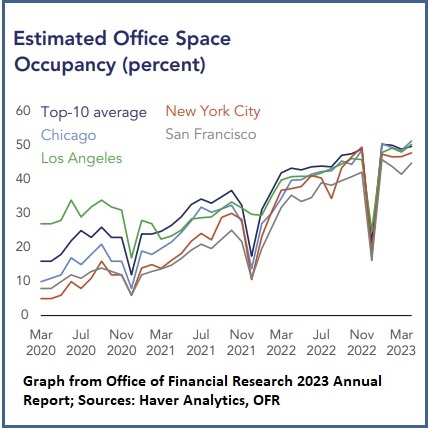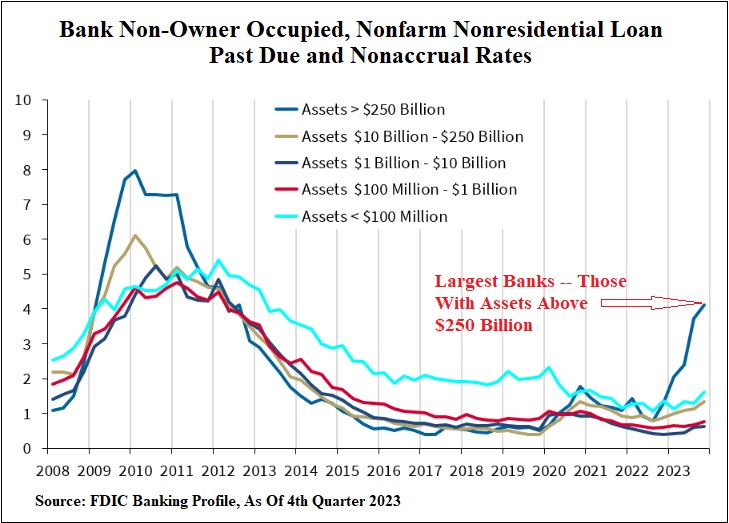SUBSCRIBE TO THIS NEWSLETTER TO RECEIVE TIMELY REPORTS
More Failed Banks and Office Building Demolitions Likely Before Real Estate Problems End, Warn Two Federal Agencies
By Pam Martens and Russ Martens: March 21, 2024 ~
Federal banking oversight agencies are in agreement: U.S. banks are facing a potential tsunami of problems with commercial real estate loans in the office space sector.
Last June 1, the Office of Financial Research (OFR), (the agency created under the Dodd-Frank financial reform legislation of 2010 to warn about financial stability risks), explained why the vacancy rate in office buildings is in dramatic contrast to the actual occupancy rate, and thus bodes poorly for the future demand for renewing office leases. OFR writes as follows:
“The health of the CRE [Commercial Real Estate] office sector is not only measured by the amount of space leased and rent paid today, but also by how much space will be required in the future. In addition to space available for sublease, we can estimate the amount of space currently occupied by employees by measuring card key swipes using the Kastle Back to Work Barometer.
“Unfortunately, future demand for office space appears weak. In addition to the growth of office space available for sublease, the amount of office space occupied by tenants remains stubbornly low…Although the current office vacancy rate is 16.4%, the average occupancy rate measured by the Kastle Back to Work Barometer is 49.8%. (Note that this represents a weekly average; daily occupancy varies). This implies a structural vacancy rate of 50.2%. Prior to the COVID-19 pandemic, office occupancy averaged close to 100%. This means that on average, firms are paying rent for twice as much space as their employees are currently using. If occupancy of existing office space remains low, current office tenants will probably renew their leases for less space—reducing office demand over time.”
The chart above accompanied the assessment. The same chart also made it into OFR’s 2023 annual report, which predicted office building demolitions were likely to occur for the less desirable office space. OFR wrote:
“High-quality space will likely outperform as the flight to quality continues, with high rents and low vacancy rates for best-in-class assets. However, second-generation space will struggle to backfill, with an increase in demolitions and conversions.”
A key entity that OFR keeps apprised of financial stability risks is the Financial Stability Oversight Council (F-SOC). It was also created under the Dodd-Frank financial reform legislation of 2010 to address the fact that financial regulators were wearing blinders when the 2008 financial crisis on Wall Street left the U.S. economy in tatters, with millions of Americans losing their jobs and their homes to foreclosure from tricked-up mortgages. F-SOC is chaired by the sitting U.S. Treasury Secretary and includes every federal banking and securities regulator. F-SOC wrote the following in its 2023 annual report:
“Commercial real estate (CRE) loans totaled almost $6 trillion as of the second quarter of 2023, and CRE represents a significant portion of the assets of many financial institutions. Banks hold a significant market share of CRE loans at 50 percent, with the rest held by various financial institutions such as insurance companies, holders of commercial mortgage-backed securities (CMBS), and debt funds. CRE is the largest loan category among almost one-half of U.S. banks, and more than one-quarter of U.S. banks have CRE loan portfolios that are large relative to the capital they hold.”
And this:
“The prices of office properties have deteriorated much more than those of other major property types in recent quarters, with an index of office property prices more than 30 percent below its pre-pandemic level as of September 2023.”
There is widespread agreement among federal banking regulators that commercial real estate in the office sector is a serious financial risk to banks. However, there is divergent opinion among two key regulators as to whether this risk is at the smaller banks or includes the largest banks — which pose an exponentially greater threat to financial stability.
On March 7, Fed Chair Jerome Powell appeared before the Senate Banking Committee to deliver his Semiannual Monetary Policy Report. In the Q&A that followed, Senator Catherine Cortez Masto (D-NV) raised the question with Powell about troubled real estate loans as a financial risk to banks.
Powell played down the real estate threat at the largest banks, stating: “There will be bank failures, but this is not the big banks. If you look at the very big banks, this is not a first order issue for any of the very large banks. It’s more smaller and medium size banks that have these issues.”
Powell might have his own agenda in playing down the risks to the mega banks on Wall Street. According to Senator Elizabeth Warren, who also sits on the Senate Banking Committee, Powell is leading the charge behind the scenes to overturn federal regulators’ proposal to require the largest banks to hold larger amounts of capital to prevent a replay of the taxpayer and Fed bailouts of these mega banks that occurred in 2008.
On the same day that Powell was testifying before the Senate Banking Committee, the Chair of the Federal Deposit Insurance Corporation (FDIC), Martin Gruenberg, was holding a press conference to release the FDIC’s latest quarterly “Banking Profile.” Gruenberg boldly revealed a serious real estate problem inside the largest banks, stating the following: (Go to 5 minutes and 12 seconds at this link.)
GRUENBERG: “The increase in noncurrent loan balances was greatest among CRE [Commercial Real Estate] loans and credit cards. Weak demand for office space has softened property values and higher interest rates are affecting credit quality and refinancing ability of office and other types of CRE loans. As a result, the noncurrent rate for nonowner occupied CRE loans is now at its highest level since first quarter of 2014, driven by portfolios at the largest banks.” (Bold emphasis added.)
According to the chart below and accompanying data provided in an Excel spreadsheet by the FDIC, past due loans on commercial real estate at the largest banks (those with more than $250 billion in assets) as of December 31 of last year are at 4.11 percent. That’s 1.66 percent higher than at the end of the fourth quarter of 2008 when banks were exploding all over Wall Street during the financial crisis. As the chart below indicates, commercial real estate problems quickly became a lot worse at the largest banks, with the past due rate reaching 7.97 by the end of the first quarter of 2010.
That 4.11 percent past due rate at the biggest banks on December 31, 2023 compares with a past due rate of 1.35 percent at banks with $10 billion to $250 billion in assets, according to the latest FDIC bank profile data. Banks with $1 billion to $10 billion in assets have a negligible past due rate of 0.64 percent.
According to a report at CommercialEdge, Central Business District (CBD) office buildings “have been hit the hardest by the changes.” They cite a Washington, D.C. 13-story building with ground-floor retail space that “sold for $18.2 million in 2023, down 70% from its 2017 price tag of $61.8 million.”



No comments:
Post a Comment
Note: Only a member of this blog may post a comment.